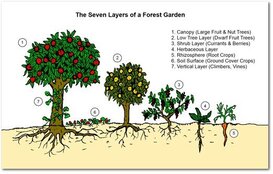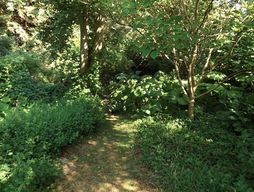
The root of the word Permaculture comes from permanent agriculture. It is a design system based on the understanding of natural ecosystems and the mimicry of their key elements.
Something that I have noticed many people being excited about is food forests and forest gardens. Read on to learn about the what, why, how and when of food forests.
Something that I have noticed many people being excited about is food forests and forest gardens. Read on to learn about the what, why, how and when of food forests.

What
Forests are self-maintaining systems that thrive with abundance and biodiversity. It was people like Masanobu Fukuoka and Bill Mollison who pioneered the food forest concept, building on traditional knowledge. They observed how many inputs go into conventional agriculture, yet forest function perfectly with no human inputs. The food forest concept was further developed by Robert Hart, Dave Jacke and Eric Toensmeier, they went on to write books on the subject. Their work lead to refining the concept of food forests and stimulated global interest, creating a surge of research and further development. A food forest is a seven-layer diverse assembly of plants, shrubs and trees that provide food, fuel, fibre, fodder, fertiliser, pharmaceuticals and fun! It is the multiple layers that make it different from an orchard. Food forest function as a living ecosystem, so they can become super productive and designed to provide year round harvests.
Forests are self-maintaining systems that thrive with abundance and biodiversity. It was people like Masanobu Fukuoka and Bill Mollison who pioneered the food forest concept, building on traditional knowledge. They observed how many inputs go into conventional agriculture, yet forest function perfectly with no human inputs. The food forest concept was further developed by Robert Hart, Dave Jacke and Eric Toensmeier, they went on to write books on the subject. Their work lead to refining the concept of food forests and stimulated global interest, creating a surge of research and further development. A food forest is a seven-layer diverse assembly of plants, shrubs and trees that provide food, fuel, fibre, fodder, fertiliser, pharmaceuticals and fun! It is the multiple layers that make it different from an orchard. Food forest function as a living ecosystem, so they can become super productive and designed to provide year round harvests.

Why
Food forests are resilient, because trees and perennials have stronger and deeper root systems than annuals and can survive and continue to yield in conditions that would ruin many annual crops. Once established food forests have better quality soil, higher moisture retaining abilities, with almost no erosion and little maintenance. They provide a form of insurance against crop failure due to pests, disease, or weather by having multiple backups of additional crops, so there is always a yield of one kind or another.
There is a big opportunity to regenerate degraded land to productivity through combining swales and or terraces with food forests. Food forests are particularly suited to stabilizing slopes and preventing erosion on hillsides. Roughly 45% of the world’s farmland is classed as sloping at an 8% angle or higher.
Food forests are resilient, because trees and perennials have stronger and deeper root systems than annuals and can survive and continue to yield in conditions that would ruin many annual crops. Once established food forests have better quality soil, higher moisture retaining abilities, with almost no erosion and little maintenance. They provide a form of insurance against crop failure due to pests, disease, or weather by having multiple backups of additional crops, so there is always a yield of one kind or another.
There is a big opportunity to regenerate degraded land to productivity through combining swales and or terraces with food forests. Food forests are particularly suited to stabilizing slopes and preventing erosion on hillsides. Roughly 45% of the world’s farmland is classed as sloping at an 8% angle or higher.

How
A sector and zone analysis will provide the information for the sound placement of a food forest. As always, following the water access, structures process will ensure a framework and highlight the limiting factors contributing to the creation of a realistic design. Implementation of the design can be done incrementally in phases of manageable strips or pockets, depending on the availability of time and resources. It can be extended and tweaked over time. Cutting and transplants can be made from the first sections and planted into new sections and lessons learned from earlier stages can also be directly applied. The biggest challenge is harvesting a food forest. This can be resolved with adequate access and harvested by hand, which makes them ideal community projects.
A sector and zone analysis will provide the information for the sound placement of a food forest. As always, following the water access, structures process will ensure a framework and highlight the limiting factors contributing to the creation of a realistic design. Implementation of the design can be done incrementally in phases of manageable strips or pockets, depending on the availability of time and resources. It can be extended and tweaked over time. Cutting and transplants can be made from the first sections and planted into new sections and lessons learned from earlier stages can also be directly applied. The biggest challenge is harvesting a food forest. This can be resolved with adequate access and harvested by hand, which makes them ideal community projects.
| When One of the reasons why the establishment of food forests can go wrong is that they do not receive enough water. Here, in the Mediterranean, the best time to plant out or extend a food forest is ideally autumn, or if not spring. This gives the system time to get established as the temperatures are milder and there is higher rainfall. Watering systems need to be in place for the dryer months. It is especially important to control the weeds in the first couple of years, typically done through planting ground covers and heavy mulching (newspapers cover with wood chips works well). |
Food forests are a good example of mimicking the functioning of natural ecosystems through the creation of a complex network of interactions. They are an interesting element to add to any land-based project and will surely benefit bio diversity and the surround areas. They can be implemented on any scale and be adapted to almost any climate and can be implemented slowly over time. It is a great learning curve and with time will provide you and yours with abundance.
Matt Prosser 28.06.2016
Matt Prosser 28.06.2016



